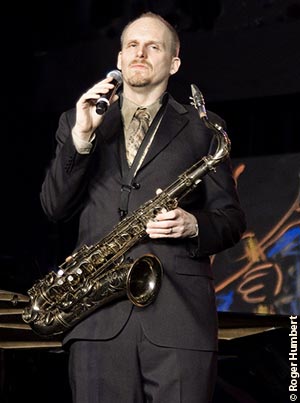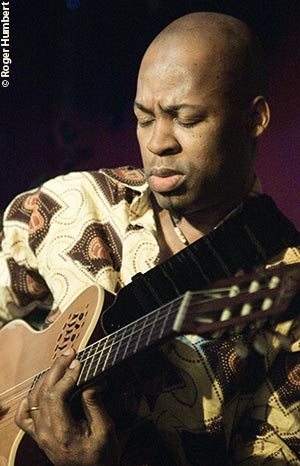| The Clifford Brown/Stan Getz All-Stars opened the show with a short set of solid jazz with strong solos that had me forgetting that these guys are students; a testament perhaps to the state of jazz education today and an example of the work the IAJE is doing in supporting promising young musicians. The members of this ensemble are chosen annually by the NEA (National Endowment for the Arts) in conjunction with the IAJE from among the high school-level applicants. They are given the opportunity to play at the annual IAJE conference and at other events such as the Monterey Jazz and the Clifford Brown Jazz festivals. The two organizations also enable them to take advantage of various educational opportunities On this occasion, the young sextet was joined by drummer Carl Allen.
Next on the bill were New York Voices with Paquito D’Rivera. The New York Voices have been collaborating on their own unique sound for over twenty years and the depth and breadth of their experience shows. Between the four singers they have the ranges covered and they use their different ranges and timbres effectively. On this night, they wove beautiful harmonies, often striking unusual chords, stretching and altering them. Sophisticated and polished yet authentic, they also demonstrated how to give life to a lyric. The words they sang were always clear and never seemed tired clichés, corny or schmaltzy. Instead, they tended to evoke complex responses as was the case with “The World Keeps You Waiting” and “As We Live and Breathe”. They performed a nice long set filled with most of the material from their new CD A Day Like Today and a piece from their Brazilian Dreams CD, “Snow Samba”, written by Paquito D’Rivera and Claudio Roditi. Paquito D’Rivera came up to join them on this tune and “Chamago” with his inimitable warm-toned clarinet warbling like a tropical bird.
The Lionel Loueke Trio capped the night with an innovative offering of original jazz. Like the New York Voices, they were also playing mainly from the material on their new CD, as yet unreleased. The three musicians of different origins (Benin, Switzerland and Hungary) displayed great creativity in a modern jazz style where Africa was markedly present in Lionel Loueke’s intricate and percussive mbira-like guitar style and the recurrent circular motion of melodic lines. Loueke’s vocalizations were always interesting and his judicious use of electronic looping and modulation effectively integrated with the total sound. Harmonica player Grégoire Maret joined the trio on the last piece adding a new dimension to the sound. Though most of the music commanded careful listening, there was at least one piece that would have had people dancing joyously in an African club.
|
|

Darmon Meader |
|

Lionel Loueke |
|



